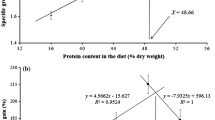Summary
Diets containing 8 or 15% protein from casein plus limiting amino acids, 25% fat and adequate levels of other nutrients for rat growth were supplemented with 0, 0.5, 1.0, 2.0 or 4% of excess L-threonine. Addition of up to 1% excess threonine had little effect on weight gains or food intakes of weanling rats, but addition of 2 and 4% threonine caused a drastic reduction in weight gains or food intakes (up to 41%); the adverse effect being more severe in rats fed lower protein diets. Addition of graded levels of excess threonine resulted in (5 to 47-fold and 4 to 20-fold) increase in concentration of free threonine in rat plasma and brain, respectively. Addition of excess threonine also caused up to 5-fold increase in plasma level of 3-methylhistidine, suggesting increased muscle protein breakdown.
Similar content being viewed by others
References
American Institute of Nutrition (1977) Report of the American Institute of Nutrition ad hoc committee on standards for nutritional studies. J Nutr 107: 1340–1348
American Institute of Nutrition (1980) Second report of the ad hoc committee on standards for nutritional studies. J Nutr 110: 1726
Ballevre O, Cadenhead A, Calder AG, Rees WD, Lobley GE, Fuller MF, Garlick PJ (1990) Quantitative partition of threonine oxidation in pigs: effect of dietary threonine. Am J Physiol 259: E483-E491
Bird MI, Nunn PB (1983) Metabolic homoeostasis of L-threonine in the normally-fed rat. Biochem J 214: 687–694
Davis AT, Austic RE (1982) Threonine metabolism of chicks fed threonine-imbalanced diets. J Nutr 112: 2177–2186
Edmonds MS, Baker DH (1987) Amino acid excesses for young pigs: effects of excess methionine, tryptophan, threonine or leucine. J Anim Sci 64: 1664–1671
FASEB (1992) Safety of amino acids used as dietary supplements, LSRO, Federation of American Societies for Experimental Biology, Bethesda, Maryland, pp viii-x
Grogan CK, Janas LM, Hendrix MK, Picciano MF (1988) Impact of nutrition on postnatal development of serine-threonine dehydratase and branched-chain keto acid dehydrogenase in the rat. Biol Neonate 54: 224–231
Growdon JH, Nader TM, Schoenfeld J, Wurtman RJ (1991) L-threonine in the treatment of spasticity. Clin Neuropharmacol 14: 403–412
Järvenpää A-L, Rassin DK, Räihä NCR, Gaull GE (1982) Milk protein quantity and quality in the term infant: II. effects on acidic and neutral amino acids. Pediatrics 70: 221–230
Kang-Lee YAE, Harper AE (1978) Threonine metabolism in vivo: effect of threonine intake and prior induction of threonine dehydratase in rats. J Nutr 108: 163–175
Kashyap S, Okamoto E, Kanaya S, Zucker C, Abildskov K, Dell RB, Heird WC (1987) Protein quality in feeding low birth weight infants: a comparison of whey-predominant versus casein-predominant formulas. Pediatrics 79: 748–755
Muramatsu K, Odagiri H, Morishita S, Takeuchi H (1971) Effect of excess levels of individual amino acids on growth of rats fed casein diets. J Nutr 101: 1117–1126
Peng Y, Gubin J, Harper AE, Vavich MG, Kemmerer AR (1973) Food intake regulation: amino acid toxicity and changes in rat brain and plasma amino acids. J Nutr 103: 608–617
Rassin DK, Gaull GE, Heinonen K, Räihä NCR (1977) Milk protein quantity and quality in low-birth-weight infants: II. effects on selected aliphatic amino acids in plasma and urine. Pediatrics 59: 407–422
Rassin DK, Sturman JA, Gaull GE (1978) Taurine and other free amino acids in milk of man and other mammals. Early Hum Dev 2: 1–13
Reddi OS (1978) Threoninemia-a new metabolic defect. J Pediatr 93: 814–816
Rigo J, Senterre J (1980) Optimal threonine intake for preterm infants fed on oral or parenteral nutrition. J Par Ent Nutr 4: 15–17
Rigo J, Verloes A, Senterre J (1989) Plasma amino acid concentrations in term infants fed human milk, a whey-predominant formula, or a whey hydrolysate formula. J Pediatr 115: 752–755
SAS Institute Inc (1985) SAS/STAT guide for personal computers, version 6 Edition. SAS Institute, Cary NC
Sarwar G, Botting HG (1990) Rapid analysis of nutritionally important free amino acids in serum and organs (liver, brain, and heart) by liquid chromatography of precolumn phenylisothiocyanate derivatives. J Assoc Off Anal Chem 73: 470–475
Sauberlich HE (1961) Studies on the toxicity and antagonism of amino acids for weanling rats. J Nutr 75: 61–72
Yamashita K, Ashida K (1971) Effect of excessive levels of lysine and threonine on the metabolism of these amino acids in rats. J Nutr 101: 1607–1614
Author information
Authors and Affiliations
Rights and permissions
About this article
Cite this article
Sarwar, G., Peace, R.W. & Botting, H.G. Influence of high dietary threonine on growth and amino acids in blood and tissues of rats. Amino Acids 8, 69–78 (1995). https://doi.org/10.1007/BF00806545
Received:
Accepted:
Issue Date:
DOI: https://doi.org/10.1007/BF00806545



